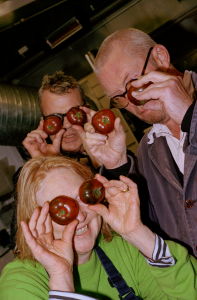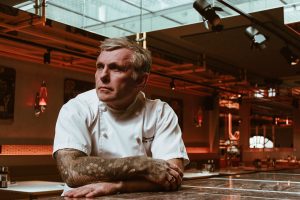After 9 courses with the Chef at Alain Ducasse at the Dorchester, a chat about his approach to cooking

The first course at the three-Michelin-starred Alain Ducasse at The Dorchester is a scallop. Placed before me, its shell is huge and Botticelli-perfect, wreathed in a fog that laps at the bed of seaweed beneath. At the centre is the scallop itself, bathed in a citrus beurre blanc the colour of morning sunlight. Our waiter, Teana, spoons Kristal caviar – Mr Ducasse’s favourite brand – over it with a silver spoon. I take videos, photographs, although my phone is too old, too shitty, to really capture its splendour, the way the black pearls of sturgeon catch the light, the way the mist billows. I take more anyway. When I eventually take a bite, I find that it is, perhaps, the best thing I have ever eaten. I sit back and close my eyes and do not say anything for a little while, a state of bliss that is maintained for the entirety of the seven-course meal.
Chef Patron of the restaurant is the Nice-born Jean-Philippe Blondet. Having worked alongside Alain Ducasse for over a decade, Blondet interprets Ducasse’s philosophy in a contemporary, ingredients-led way that references his French Riviera upbringing. After the meal, I caught up with him to discuss his approach to creativity, his biggest inspirations – and the dish he always cooks at home.

How has your background – your upbringing, your past roles, your life in general – influenced your work?
The main thing is my use of olive oil; as in Provence, where I grew up, almost everything is cooked with olive oil, and only a bit of butter and cream. And of course, there’s the produce of the French Riviera, where I was lucky enough to grow up surrounded by all the beautiful vegetables, the fruit… I’ve travelled quite a lot and to find a place like that – in terms of living, produce, lifestyle, you have everything. Even just going with my parents to the market on a Saturday and seeing all the people who are coming to sell the things they produce all through the week.
But the way my background influences my work is much more about the way that I manage people, the way I deal with them. In the past, I’ve worked in kitchens that have used the old style of management, and I really don’t like that, I find that very difficult. You know, you learn from both the good things and the things you’d like to change.
Do you cook at home? What’s your signature weeknight meal?
I’m cooking a bit, but not a lot, to be honest. But what I like to make for my wife and son are crêpes. I have to say, I think my crêpes are the best I’ve eaten… . Leave it until it’s a bit caramelised and starts to brown, and at that point you add a bit of sugar, and with the humidity of the butter the crêpes become soft in the middle and very crispy on the outside.
How do you find creative inspiration?
This is a big, big question. Basically, I don’t have a method – I never think when I’m doing something. Creativity just comes. I can be inspired by a lot of things: I can be inspired by texture; by the weather; by what’s happening outside; by the ingredients; by my childhood memories. I never sit at the table with a pen and paper to try and design or think about a dish. Instead, it all comes very naturally. Of course, seasons are super important. It’s a one-year process – we’re now in the middle of the season, so it’d be too late for me to create a dish to go on the menu now, but I’d try to work on it, put it to the side and take it back up the following year. That way I have more time to think and mature the idea.
And on a more practical level, how do you design the menu at Alain Ducasse? Can you walk me through how you construct that kind of culinary experience?
There’s a journey there, from the first dish to the one you’re eating at the finish. In terms of flavour, it’s very important that you elevate the journey: acidity, freshness, creaminess. So usually you start with the scallop, which is very round, very easy, and we use a touch of lemon to make it a little lighter, a little more on the citrus side.
And after you have the aubergine and the sardine with a much more mature flavour: there’s the salty, fishy taste of the sardine, but you also have the fresh citrus flavour within the aubergine and the lemon balm. All the time, we play between comfort and innovation, comfort and innovation, to create a different experience.
Following the aubergine, you have the chicken quenelles. It’s one of our most iconic dishes – and the first dish we created. It’s the root of the restaurant, so we’ve kept it on the menu. But I believe, finally, that I’ve got the right dish to take over, but it takes a long time.
Next, we have a Cornish turbot, which combines seaweed and apricots for a real feeling of freshness. That’s followed by the tomato, which is a fuller flavour – Provence, French Riviera, the end of summer. And after there’s the beef, which for me is the most beautiful dish that you can find in the UK. And the dessert at the moment is figs, because we’re at the end of the season, before the plums take over.
The menu changes quite often – if a diner comes in January and then comes in August, they probably won’t eat the same thing. Can you tell me more about why that is?
We change the menu very often because we need to follow the seasons; we need to follow the ingredients you can find here in the markets. For a three-Michelin-star, we’re changing the menu much more often than our colleagues at similar restaurants.
It’s a lot about feeling, about moments; how I can find the ingredients around me, and less thinking consciously about it. That’s the philosophy of the kitchen.
What did you want to be when you were younger? Were you always focused on being a chef?
I always knew I wanted to be a chef. In the beginning, I wanted to be a pastry chef – I used to make a lot of cake – and from the age of twelve, I started working occasionally at patisseries in my city (this was thirty years ago, it was ok back then…). And when I started pastry school and had to learn to scale everything, I realised it wasn’t for me. Then I decided to be a chef – I was very lucky to be accepted to one of the most iconic hospitality schools in France, and after that I started to train in Michelin-starred restaurants.
And what was it about cooking that appealed so much to you?
When you cook, every day is different. You can’t follow a recipe, if you follow a recipe you’ll be like a robot, you’ll cut all the emotion, the feeling you need to provide to your customers, guests, family, whoever they are. You need to understand what you’re doing, you need to understand the tomato or the carrot or the courgette you’re cooking; you need to understand what has happened before, and why this is the direction, what you can bring.
What’s your favourite dish on the menu?
This question is very, very difficult, because I created all of them – so obviously I like them all! It’s like if you have two children and someone asks which is your favourite. I’d say the last one is my favourite, the beef. But next week we change the menu, so the new babies are coming… The beef for me was so important – I mean the tomato element of the dish even more so, because the goal here was for the tomatoes to be the star, with the meat on the side.
What would be your ideal last meal?
I would say riz au lait, rice pudding. It’s my favourite, and it has a lot of childhood memories attached.




